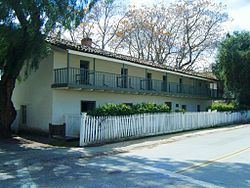Built 1841 CHISL # 179 Designated CHISL March 6, 1935 Area 4,000 m² Added to NRHP 15 April 1970 | NRHP Reference # 70000141 Designated NHL May 15, 1970 Opened 1841 Architectural style American Colonial Architect José Castro | |
 | ||
Location S side of the Plaza, San Juan Bautista, California Similar San Juan Bautista State Hist, Anza House, Los Alamos Ranch H, Hubert H Bancroft Ranch H, Frank Norris Cabin | ||
Jose Castro House, now known as the Castro-Breen Adobe, in San Juan Bautista, California, USA, is a historic adobe home built by José Castro in 1840. Castro was Commandant General of Alta California. In 1848 Castro sold the house to Patrick Breen, survivor of the ill-fated Donner party of 1846, and the Breen family lived in the house until 1935. They sold it to the State of California who adapted it as a museum and incorporated it into the San Juan Bautista Plaza Historic District.
Contents
Origins
His father José Tiburcio Castro was a soldier, member of the diputacion (Alta California legislature), the administrator of Mission San Juan Bautista after it was secularized, and grantee of Rancho Sausal. His father used his authority to distribute mission lands to relatives and friends. He gave his son land on the San Juan Bautista plaza, who built an adobe house there in 1841. Castro used the house as an administrative base for his military operations and let his secretary use as a residence.
Architecture
The house, also known as the Castro-Breen Adobe, is a two-story Monterey-colonial style adobe, with a wood frame and second story porch. The Monterey style of architecture originated in California and blended Spanish colonial architecture with New England style. Massachusetts native Thomas O. Larkin built the first known Monterey house in 1835 in Monterey, California. The wood frame allows for more windows than regular adobe would have and can support a second floor. In the Monterey style, the porch and gable roof protect the adobe bricks and outer shell, made of mud, from water damage. The pane glass windows beside the front door of the José Castro House are not typical of Monterey architecture and reflect the influence of Greek Revival architecture, which was also popular during the 19th century. Today, the José Castro House property includes a half-acre orchard and garden.
Current uses
San Juan Bautista State Historic Park uses the José Castro House as a fully furnished museum, where visitors are welcome to explore and see what the inside of the house looked like in the mid-19th century. Several other historic buildings in the plaza that are part of the San Juan Bautista Historic District are also open to the public. These buildings include the San Juan Bautista Mission, Plaza Hotel, and Zanetta House. The park offers guided tours of the plaza, a gift shop in the Plaza Hotel, costumed reenactments every first Saturday of the month, and activities for children. The San Juan Bautista Mission is a stop on the Juan Bautista de Anza National Historic Trail.
Landmark status
The Jose Castro House was declared a California Historical Landmark in 1935 and a National Historic Landmark in 1970. It is part of the San Juan Bautista Plaza Historic District, which is itself a National Historic Landmark District. The house has been open to the public since 1935.
